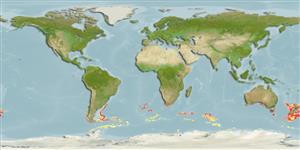>
Zeiformes (Dories) >
Oreosomatidae (Oreos) > Pseudocyttinae
Etymology: Pseudocyttus: Greek, pseudes = false + Greek, kyttaros, kytos = a convex cavity.
Environment: milieu / climate zone / depth range / distribution range
Écologie
marin bathydémersal; océanodrome (Ref. 51243); profondeur 400 - 1500 m (Ref. 5194), usually 900 - 1100 m (Ref. 36731). Deep-water; 34°S - 67°S, 90°W - 176°W (Ref. 27159)
Southwest Atlantic: off Uruguay to Argentina and the Falklands. Southeast Atlantic: Namibia to South Africa, including the northern part of Walvis Ridge (Ref. 6545). South Pacific: off southern Chile, Bellingshausen and Australian-Antarctic Basin to New Zealand, New South Wales and Tasmania, Australia and the Kerguelen Islands.
Length at first maturity / Taille / Poids / Âge
Maturity: Lm 40.0 range ? - 41 cm
Max length : 68.0 cm TL mâle / non sexé; (Ref. 58312); common length : 40.0 cm TL mâle / non sexé; (Ref. 9258); poids max. publié: 5.0 kg (Ref. 6390); âge max. reporté: 100 années (Ref. 27140)
Épines dorsales (Total) : 5 - 7; Rayons mous dorsaux (Total) : 33 - 36; Épines anales: 2 - 3; Rayons mous anaux: 31 - 34; Vertèbres: 40 - 43. First dorsal spine longer than second dorsal spine. Opercles fully scaled (Ref. 27159).
Female adult chocolate brown in color with darker fins; prejuveniles silvery with numerous dark spots of various sizes which become larger with age (Ref. 6548).
Inhabit continental slopes of all southern continents (Ref. 6545). Adults found near the bottom; juveniles near the surface, usually in association with krill (Ref. 5194). Feed mainly on salps (Ref. 27150). Eggs float near the sea surface and larvae also inhabit surface waters (Ref. 6390). There is no vertical migration during the day or night (Ref. 27150).
Displays seasonally synchronised reproduction (Ref. 6390).
Heemstra, P.C., 1990. Oreosomatidae. p. 226-228. In O. Gon and P.C. Heemstra (eds.) Fishes of the Southern Ocean. J.L.B. Smith Institute of Ichthyology, Grahamstown, South Africa. (Ref. 5194)
Statut dans la liste rouge de l'IUCN (Ref. 130435: Version 2024-2)
Menace pour l'homme
Harmless
Utilisations par l'homme
Pêcheries: commercial
Outils
Articles particuliers
Télécharger en XML
Sources Internet
Estimates based on models
Preferred temperature (Ref.
123201): 2.1 - 6.1, mean 4.2 °C (based on 189 cells).
Phylogenetic diversity index (Ref.
82804): PD
50 = 1.0010 [Uniqueness, from 0.5 = low to 2.0 = high].
Bayesian length-weight: a=0.01995 (0.00813 - 0.04898), b=2.99 (2.77 - 3.21), in cm total length, based on LWR estimates for this (Sub)family-body shape (Ref.
93245).
Niveau trophique (Ref.
69278): 3.6 ±0.47 se; based on food items.
Résilience (Ref.
120179): Très faible, temps minimum de doublement de population supérieur à 14 ans (K=0.07; tmax=100; tm=31; Fec=6,000).
Fishing Vulnerability (Ref.
59153): High to very high vulnerability (72 of 100).
Climate Vulnerability (Ref.
125649): Moderate vulnerability (39 of 100).
Nutrients (Ref.
124155): Calcium = 16.2 [8.5, 36.6] mg/100g; Iron = 0.416 [0.153, 0.905] mg/100g; Protein = 17.2 [14.6, 20.0] %; Omega3 = 0.332 [0.167, 0.702] g/100g; Selenium = 24.3 [9.3, 71.5] μg/100g; VitaminA = 11.1 [1.8, 67.9] μg/100g; Zinc = 0.335 [0.207, 0.526] mg/100g (wet weight);
